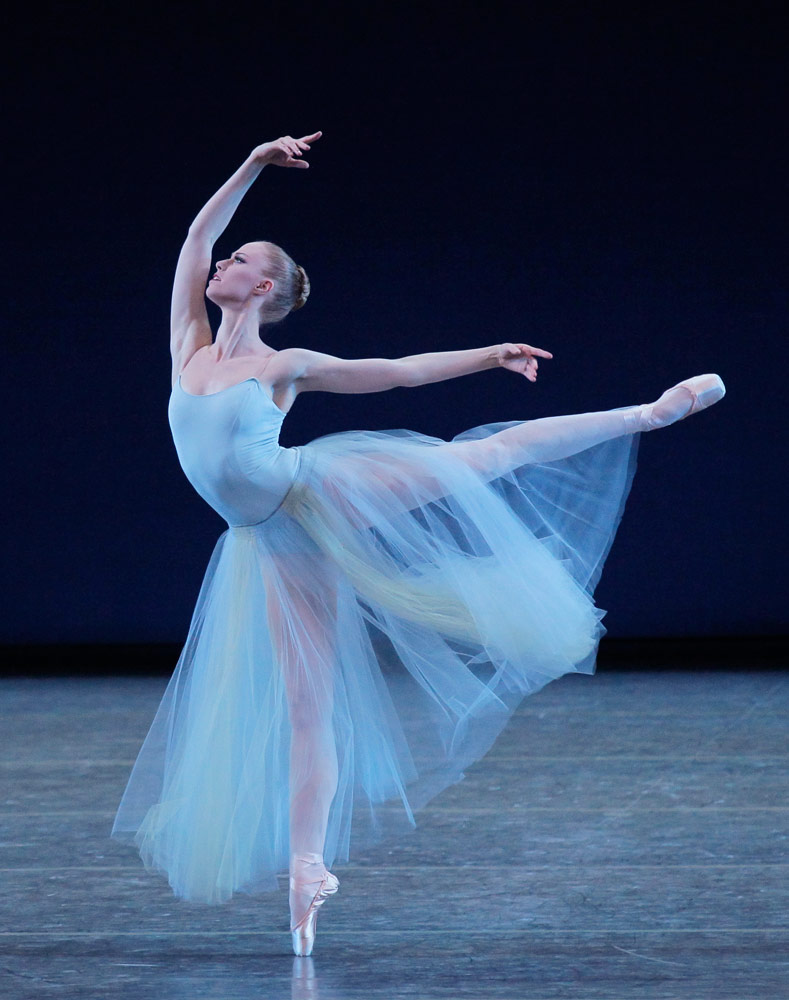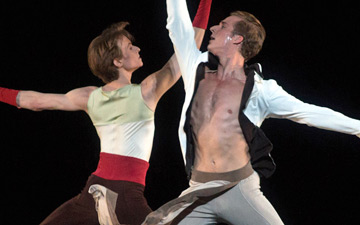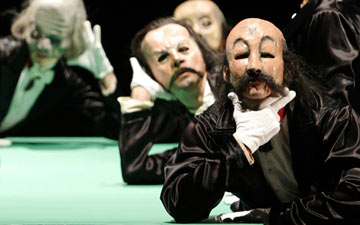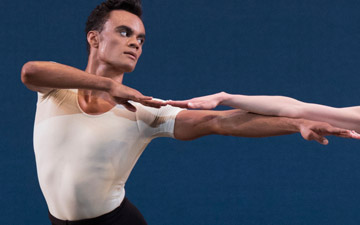
© Paul Kolnik. (Click image for larger version)
New York City Ballet
Jan. 20: Serenade, Agon, Symphony in C
Jan. 22: Donizetti Variations, La Valse, Chaconne
New York, David H. Koch Theater
20, 22 January 2015
www.nycballet.com
Balanchine Six Ways
In recent seasons New York City Ballet has gotten into the habit of starting things off with a week or two of Balanchine. It’s an excellent idea. These Balanchine evenings quickly establish the company’s core values: musicality, speed, lightness of touch, spaciousness, style. They also impress upon the audience the vast range of balletic modes in which the choreographer worked. In just two programs this week (Jan. 20 and Jan. 22), we saw the romantic Balanchine (Serenade), the classicist (Symphony in C), the modernist (Agon), the satirist (La Valse), the wit (Donizetti Variations) and the incurable dreamer (Chaconne). The ballets are not only worlds in themselves but, taken as a group, they seem to encompass most of ballet.
Then there is his understanding of music. The steps capture not only the structure and phrasing of the music but the story behind the notes. A lover of Tchaikovsky can listen to a Serenade for Strings a hundred times, and yet I would wager that his understanding of the piece would be enriched by Balanchine’s 1934 ballet. Agon forever changes how one hears Stravinsky.

© Paul Kolnik. (Click image for larger version)
Given that the company is dancing so well these days, the stories behind the music come across with particular vividness. The dancers are doing more than just dancing the steps; they are transmitting a style, an ethos and a wealth of choreographic detail. It’s true, at present the women are more remarkable than the men. There is currently only one real male virtuoso capable of consistently pulling off the hyper-charged bravura choreography in ballets like Donizetti Variations, and that is Joaquín de Luz, who has been with the company for 11 years. As with other ballet companies, one could wish for greater racial diversity.
Opening night (Jan. 20) began with a moving rendition of Serenade, led by Sterling Hyltin as the woman whose death and transfiguration the ballet seems to describe. Hyltin has a skittish, gazelle-like quality tinged with an edge of emotion. Her footwork is sharp, pointed, as if she were dancing on hot coals; meanwhile, her arms and hands, tendrilly and fluid, have a life of their own. Beneath this heightened delicacy, she’s a little wild. In Serenade, she seemed most at home in the second-movement waltz with Robert Fairchild – freshly returned from his Gallic success in An American in Paris – dipping and gliding in his arms, flying across the stage in windswept jumps. But the standout in Serenade was Teresa Reichlen (in the role sometimes referred to as the “Dark Angel”), who burst upon the stage, twisting, bending, and whirling with the force of a natural phenomenon.

© Paul Kolnik. (Click image for larger version)
Hyltin came more fully into her own two days later (Jan. 22), in her début as the central figure in La Valse, which she danced with a mix of sophistication and slightly crazed abandon. Her depiction of the character’s uncontrollable desire for the unknown – in the shape of a mysterious man who enters the scene late in the game – went a long way toward explaining the ballet’s final immolation. This ballet exemplifies Balanchine’s instinct for distilling the essence of a drama and its corresponding piece of music; in this case, he exploits a vein of nastiness and danger in Ravel’s Valses Nobles et Sentimentales and La Valse. (In comparison, Frederick Ashton’s 1947 Valses Nobles et Sentimentales looks rather tame.)
The work is populated by members of a shallow, mindlessly cruel society, oblivious of the dark forces raging around them. It was made in 1951 for the urbane, sophisticated Tanaquil LeClercq, but it could just as easily have described the decadent world of the fin de siècle or the building storm before either of the World Wars. Gloved socialites, dressed in long skirts, preen and vie for attention. The women’s poses are exaggerated: jutting hips, tilted heads, hands twisted and fingers splayed. (The hands are a kind of fetish.) The men pay court; the women accept their attentions but pull away sharply at the slightest hint of emotion. Hyltin plays the role of an ingénue whose movements already betray traces of cunning; she vamps and whirls, simulating sincerity. A stranger enters – an uncharacteristically grave Amar Ramasar – and gives her jewels, which she eagerly accepts. She plunges her arms, like snakes, into long black gloves. And suddenly her sophistication melts; she is swept away. Ramasar and Hyltin’s intoxicated waltz – head rolling, arms flying – was mesmerizing, just as it should be. By the end, Hyltin dangled lifeless in her partner’s arms. The orchestra, under the baton of Daniel Capps, communicated the boozy sweep of Ravel’s music.

© Paul Kolnik. (Click image for larger version)
The highlight of opening night was the company’s performance of Symphony in C, a radiant work originally created (under the name La Palais de Cristal) for the Paris Opéra Ballet, in 1947. This is an example of Balanchine as brilliant classicist, delighting in the ABC’s of ballet: the shifts of weight and oppositions that define épaulement, the line of the leg, the contrasts of rounded and straight arms, the sharpness of the women’s pointes. Each section has a separate cast and one or two key steps: tendus, swoons, chassés and bobs, patter of the feet, turns in which the free leg goes out and then in, as if gathering up a package. The ballerina who leads each section offers up her specialty, repeated with variations for maximum effect. In the first movement, presentational and slightly emphatic, Ashley Bouder was brilliant, commanding, spinning like a top, diving into penchés, hopping from one leg to another. (Though it must be said she seemed happier on her own than in the hands of her partner, a slightly stolid Chase Finlay). In the slow, legato second movement, Sara Mearns was lost in a dream, moved by forces beyond her command. Lauren Lovette and Gonzalo García were all charm in the third. And in the fourth, Brittany Pollack displayed impressive speed and precision. In the finale all the steps were brought out again, displayed like a selection of jewels, performed by the whole cast. It is one of the most satisfying endings in ballet. The stage becomes a brilliantly animated space filled with countless bodies, legs and arms moving now in unison, now in counterpoint. The overall effect, sustained by Bizet’s bubbly music, is euphoric.

© Paul Kolnik. (Click image for larger version)
The other ballets, if less ecstatic, were convincingly performed, particularly Donizetti Variations in which Bouder and De Luz dazzled with their technique, particularly in turns that seemed to speed up and slow down at will. Agon was stylish but a little cold. As often happens at the beginning of the season, there were a few jitters and slip-and-falls. A partnering snafu marred one of the secondary pas de deux in Chaconne. Two people fell on Jan. 22, Balanchine’s birthday. The orchestra had some low points as well, as when a horn player in Symphony in C blundered once, then twice, and finally seemed to throw in the towel for the rest of the phrase. In Chaconne Tyler Angle’s footwork could have been cleaner – and Maria Kowroski’s a bit more scintillating – but the famous opening pas de deux, in which the ballerina propels herself through the air like a zeppelin, was as cosmic as I’ve ever seen it.
A few of the newer dancers stood out, particularly Claire Kretzschmar and Clara Miller (still an apprentice). Kretzschmar, as leggy and rangy as the young Wendy Whelan, dances with a kind of irrepressible hunger for movement, face beaming. Miller, who recently danced the role of the showgirl in Balanchine’s Western Symphony at the School of American Ballet’s spring workshop performance (captured by Live from Lincoln Center ) is tall, assured, preternaturally serene. Their confidence bodes well for the future of Balanchine, which bodes well for us all.

















You must be logged in to post a comment.